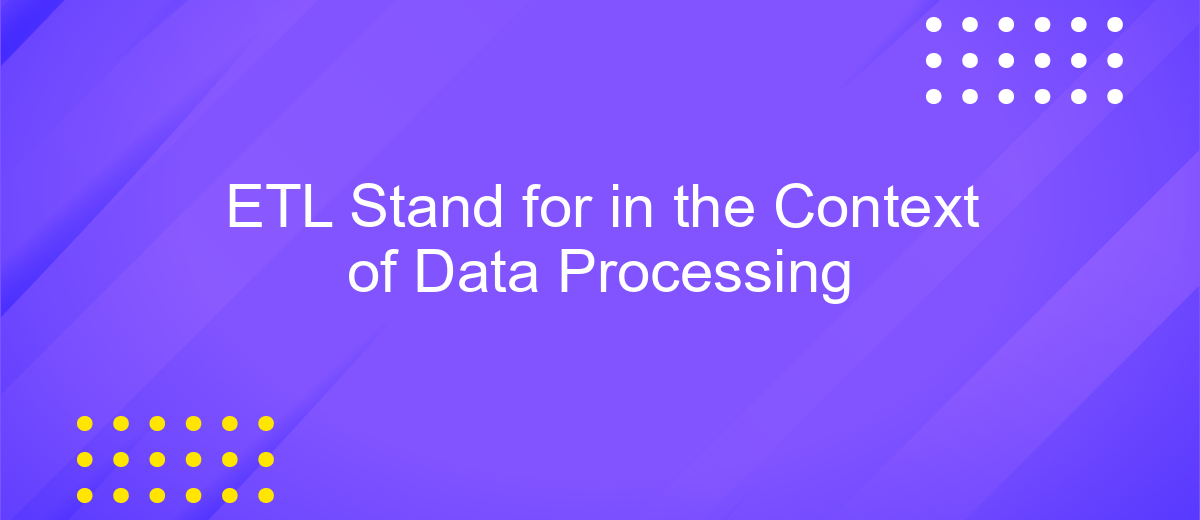ETL Stand for in the Context of Data Processing
In the realm of data processing, ETL stands for Extract, Transform, Load. This crucial process involves extracting data from various sources, transforming it into a suitable format, and loading it into a destination database or data warehouse. ETL is fundamental for ensuring data integrity and accessibility, enabling organizations to make informed decisions based on comprehensive and accurate information.
Introduction
In the realm of data processing, ETL stands for Extract, Transform, and Load. This process is fundamental for organizations that need to move and transform data from various sources into a centralized data warehouse or database. ETL ensures that data is accurately extracted from multiple sources, transformed into a suitable format, and loaded into a target system for analysis and reporting.
- Extract: This phase involves retrieving data from different sources such as databases, APIs, and flat files.
- Transform: During this stage, the extracted data is cleansed, enriched, and converted into a desired format or structure.
- Load: The final phase where the transformed data is loaded into the target system, such as a data warehouse or a business intelligence platform.
With the increasing complexity of data ecosystems, tools like ApiX-Drive have become essential. ApiX-Drive simplifies the integration process by automating the extraction and transformation of data from various services, ensuring seamless data flow into your target systems. This not only saves time but also enhances the accuracy and reliability of your data processing workflows.
What is ETL?

ETL stands for Extract, Transform, and Load, which are the three fundamental steps in the data processing pipeline. This process involves extracting data from various sources, transforming it into a suitable format, and then loading it into a target database or data warehouse. ETL is crucial for integrating data from disparate systems, ensuring data consistency, and making it accessible for analysis and reporting. By automating these steps, organizations can streamline their data workflows and improve decision-making processes.
The extraction phase involves retrieving data from different sources such as databases, APIs, or flat files. The transformation phase includes cleaning, filtering, and enriching the data to meet specific business requirements. Finally, the loading phase involves importing the transformed data into a target system. Services like ApiX-Drive can simplify the ETL process by providing tools for seamless data integration, enabling businesses to connect various applications and automate data workflows efficiently.
The ETL Process

The ETL process, which stands for Extract, Transform, Load, is a crucial component in data processing and integration. It involves three primary steps that ensure data is accurately and efficiently moved from source systems to a data warehouse or other target systems.
- Extract: This step involves retrieving data from various source systems, such as databases, APIs, or flat files. The goal is to collect all relevant data without impacting the source system's performance.
- Transform: During this phase, the extracted data is cleaned, formatted, and transformed into a suitable structure. This may involve filtering out unnecessary information, aggregating data, or converting data types to ensure consistency and usability.
- Load: The final step is loading the transformed data into the target system, such as a data warehouse or analytics platform. This stage ensures that the data is available for analysis and reporting.
Services like ApiX-Drive can simplify the ETL process by automating integrations between various data sources and target systems. With its user-friendly interface and robust features, ApiX-Drive helps streamline data workflows, making it easier to manage and utilize data effectively.
Benefits of ETL

ETL (Extract, Transform, Load) is a crucial process in data management and analytics, enabling organizations to efficiently handle large volumes of data from various sources. One of the primary benefits of ETL is its ability to consolidate disparate data into a single, unified view, which greatly enhances data analysis and decision-making capabilities.
Another significant advantage of ETL is its capacity to improve data quality. During the transformation phase, data is cleansed, filtered, and standardized, ensuring that only accurate and relevant information is loaded into the target system. This process helps in eliminating inconsistencies and errors, leading to more reliable insights.
- Data Integration: ETL facilitates the integration of data from multiple sources into a centralized repository.
- Improved Data Quality: Cleansing and standardization processes enhance the accuracy and reliability of data.
- Enhanced Performance: ETL systems are optimized for handling large datasets efficiently.
- Scalability: ETL processes can be scaled to accommodate growing data volumes and complexity.
For businesses looking to streamline their data integration efforts, services like ApiX-Drive offer powerful solutions. ApiX-Drive simplifies the setup of data pipelines, enabling seamless integration with various applications and databases. This not only saves time but also ensures that data is consistently up-to-date and ready for analysis.
Challenges of ETL
One of the primary challenges of ETL (Extract, Transform, Load) processes is handling the complexity and diversity of data sources. Data can come from various platforms, each with its own format, structure, and quality. Ensuring that the data is accurately extracted, properly transformed to fit the target schema, and loaded without errors requires meticulous planning and robust tools. Additionally, maintaining data consistency and integrity during these processes can be particularly challenging, especially when dealing with real-time data streams.
Another significant challenge is the need for seamless integration between different systems. Setting up and maintaining these integrations can be time-consuming and resource-intensive. Services like ApiX-Drive can simplify this aspect by providing a user-friendly platform for automating data flows between various applications. ApiX-Drive allows users to set up integrations without extensive technical knowledge, ensuring that data is consistently and accurately transferred between systems. This not only reduces the workload on IT teams but also enhances the overall efficiency of the ETL process.
FAQ
What does ETL stand for in the context of data processing?
Why is ETL important for businesses?
How does the ETL process work?
What are some common challenges in implementing ETL processes?
Can ETL processes be automated?
Strive to take your business to the next level, achieve your goals faster and more efficiently? Apix-Drive is your reliable assistant for these tasks. An online service and application connector will help you automate key business processes and get rid of the routine. You and your employees will free up time for important core tasks. Try Apix-Drive features for free to see the effectiveness of the online connector for yourself.

